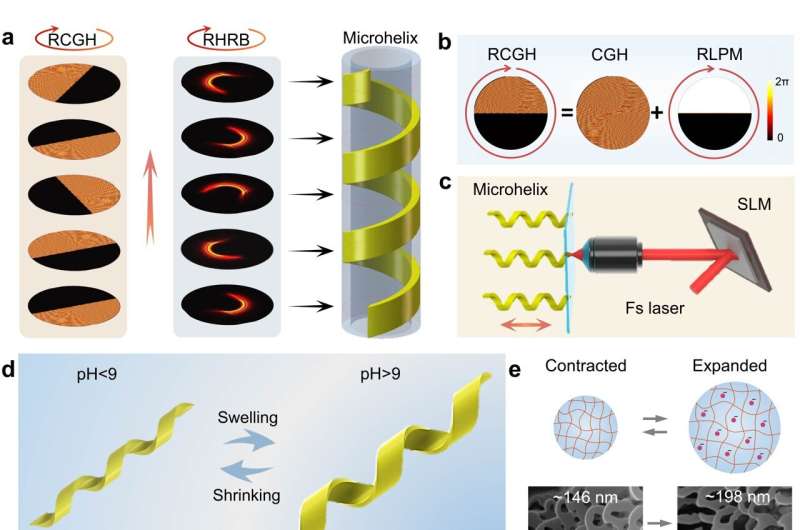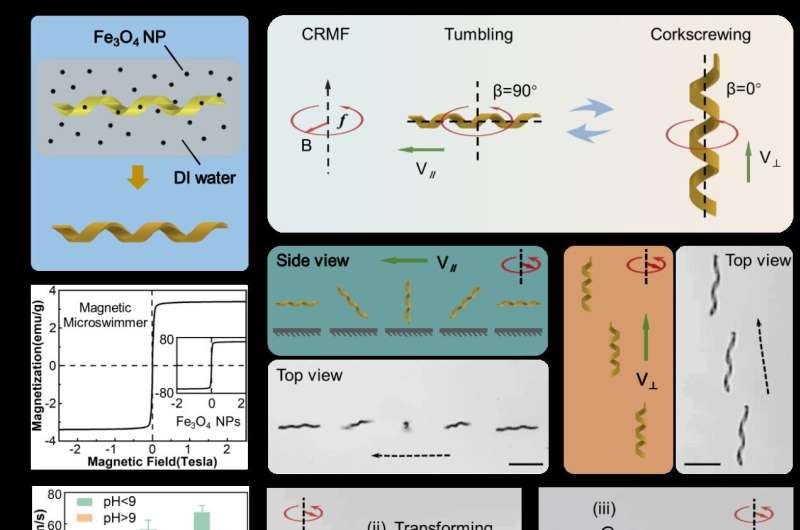This article has been reviewed according to Science X's editorial process and policies. Editors have highlighted the following attributes while ensuring the content's credibility:
fact-checked
proofread
Shape-changing helical microswimmers could revolutionize biomedical applications

Artificial helical microswimmers with shape-morphing capabilities and adaptive locomotion are promising for precision medicine and noninvasive surgery. However, current fabrication methods are slow and limited.
A new rotary holographic processing strategy can rapidly produce stimuli-responsive helical microswimmers of different sizes and morphologies. They can dynamically transition between tumbling and corkscrewing motions. It would allow them to navigate complex terrain and achieve targeted drug delivery. This holds considerable promise for diverse precision treatments and biomedical applications.
Microorganisms, such as bacteria and sperm, can undergo adaptive shape morphing to optimize their locomotion mechanisms in the environment, which enables them to navigate complex barriers and improve survival. Inspired by this autonomous behavior, artificial reconfigurable microrobots have been proposed to realize similar adaptation capabilities.
Helical microswimmers are particularly promising for biomedical applications because of their unique propulsion mechanism. Under a rotating magnetic field, helical microswimmers can transition dynamically between tumbling and corkscrewing motions, allowing them to navigate complex terrain and achieve targeted drug delivery.
In a new paper published in Light: Advanced Manufacturing, a team led by Professor Jiawen Li from the University of Science and Technology of China has developed new ways to make helical microswimmers that are very small, with dimensions in the micrometer range. This is important because many biological structures, such as cells, capillaries, and wrinkles on cell surfaces, are also very small.
Microscale helical microswimmers are promising tools for biomedical applications, such as drug delivery and targeted therapy. However, some challenges still need to be addressed before these microswimmers can be widely used in clinical practice.
One challenge is the fabrication of microscale helical microswimmers. Femtosecond direct laser writing (fs-DLW) is a powerful tool for fabricating complex 3D structures with high resolution, but it is a slow and inefficient process. This makes it difficult to produce large quantities of microswimmers quickly.

Another challenge is the adaptive locomotion of microswimmers in complex environments. Inside the body, pH values vary among different tissues, and numerous microchannels and obstacles exist. Microswimmers need to be able to sense their environment and adapt their locomotion accordingly to reach their target destination.
Researchers are addressing these challenges. One approach is to develop new fabrication methods that are more efficient and scalable than fs-DLW. Another approach is to design microswimmers that are more responsive to environmental stimuli and can adapt their locomotion accordingly.
In this study, researchers developed a new method for fabricating pH-responsive helical hydrogel microswimmers. This method is called rotary holographic processing and is much faster than traditional methods. It can produce microswimmers in less than a second, approximately one hundred times faster than the point-by-point scanning strategy.
The microswimmers are made of hydrogel, which is a type of material that can absorb water. This makes the microswimmers responsive to pH changes. When the pH of the surrounding environment changes, the microswimmers change shape. This shape change allows the microswimmers to move in different ways.
Under a constant rotating magnetic field, the microswimmers can tumble or corkscrew. The type of motion depends on the pH of the environment. In a low pH environment, the microswimmers contract and tumble. In a high pH environment, the microswimmers expand and corkscrew.
The researchers assessed the microswimmers in various conditions and found that they could traverse complex terrains and deliver drugs to targeted cells. This suggests that rotary holographic processing is a promising method for fabricating microswimmers for biomedical applications.
This research suggests that rotary holographic processing is a promising new method for fabricating microswimmers for biomedical applications. The microswimmers are fast, reconfigurable, and able to navigate complex environments. This makes them ideal for targeted drug delivery and cell therapy tasks.
More information: Rui Li et al, Rapid fabrication of reconfigurable helical microswimmers with environmentally adaptive locomotion, Light: Advanced Manufacturing (2023). DOI: 10.37188/lam.2023.029
Provided by TranSpread




















